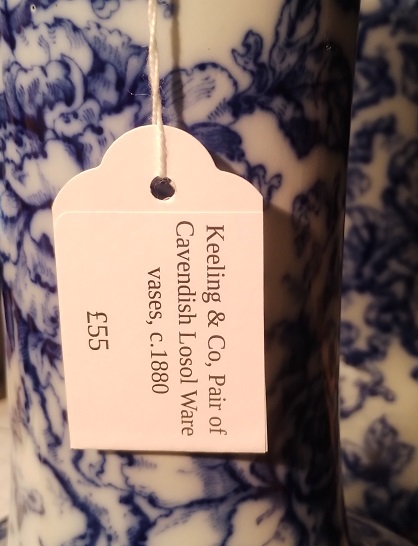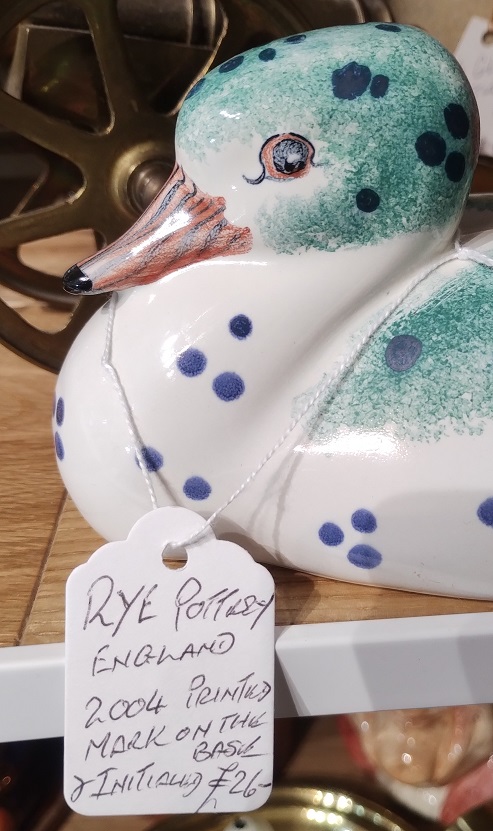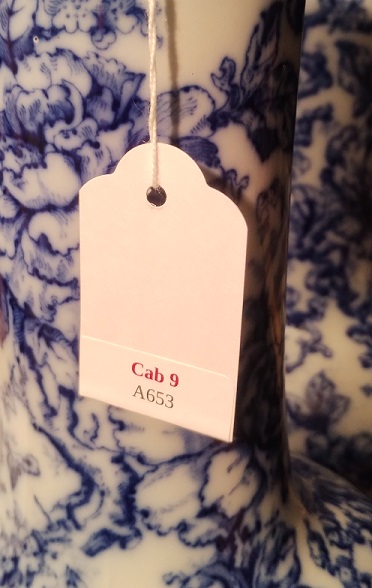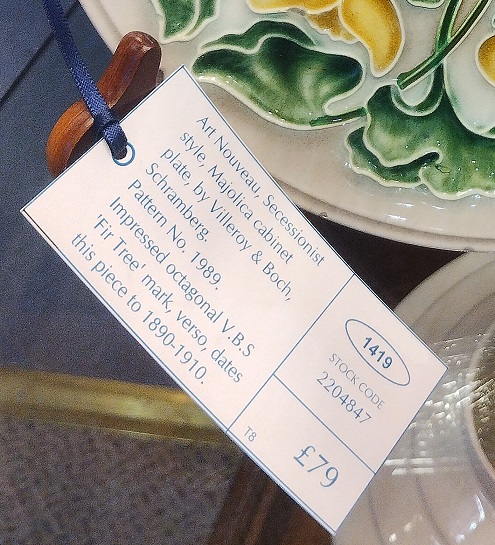Walk into any multi-dealer antiques shop and you can expect to find every item labelled. If you’re interested in an item, it’s an obvious comment that you should, as the saying goes, “Always read the label”, but actually there’s more to it than you might realise. This posting will help you to get the most from what’s written and what can be implied from those few words in front of you.

Why are items always labelled?
In a single owner/dealer antiques shop you’ll sometimes find the labelling of items is a bit sparse. I have to say I find this a bit frustrating. I think the theory is that someone who is really interested in an item, rather than just browsing, will ask about it. This gives the owner the chance to engage with the potential customer and improve their chances of making as sale, whilst not having to worry much about people just having a look.
In a multi-dealer antiques shop, most of the dealers will not be around most the time, so every item needs to be labelled. Indeed, one of the most telling signs that multiple dealers are operating from a shop is the proliferation of labels. Very few shops insist that every dealer uses the same style of label so you will see a range of label styles, each reflecting a little of the dealers’ personalities.
As I’m fairly new to selling, I would admit to spending an inordinate amount of time thinking how best to create and format labels. I try to do a bit of reasearch on most things I sell and packing all the information you want onto a small piece of card and still have it be readable is an art in itself, especially if your handwriting is illegible.

You can read this handwritten label so it’s clearly not one I’ve done! A clever use of portrate format for the label means the text is the correct way round as the label hangs down. If you can do it, hand written labels always look good. The dealer code and other information are on the back
However it’s done, I can tell you that labelling every item in your stock is a laborious task, but since it provides the only link you have with a customer, it’s really vital. Even if you spend some time working in the shop, you rely on other people to sell your items when you’re not there. They probably don’t know as much about your stock as you do, so the information on the label helps them every bit as much as it promotes an item to a potential customer. One of the skills of working in an antiques shop is expanding a bit on the few words provided by the dealer to an interested customer. I often do a bit of research after the sale, but usually feel it’s a bit late by then.
Labels for sales tracking

The second big use of labels concerns the tracking of sales in the shop. If you purchase something in an antiques shop you’ll see the label is removed and retained by the shop. These are kept safe until the dealer’s end of month comes around. As a buyer, if there’s information you want to keep a note of, please ask to copy of what’s written on the label (or take a photograph).
At the end of the dealer’s month (which can be fixed to any day in the month), the accumulated labels are listed out. The selling price of each item is totalled to calculate how much the dealer is owed by the shop for the month’s sales (after deducting shop fees).
So you can see why the label is really important for the dealer and why you can expect to see a dealer code or name on every label. Sometimes this is just a cabinet number but more often it will be a set of initials. Why should this matter to you as a customer? This is where it gets subtle.
Matching dealer codes for better discounts
As I’ve written previously, you can always ask for a discount when buying from an antiques shop or dealer. Antiques shops usually have a minimum price below which no discounts will be given. This is typically set around £20 to £30. Margins for a dealer at that level are tiny, so please don’t be pushy about it.
So what if you walk into a shop and buy ten items that come to a total of £150? Generally if the items all come from different dealers you will only get a discount from those items over the minimum discount level. If they are all under that level then I’m afraid you should expect to pay full ticket price for everything.
However, if you’ve looked at the labels and can see that several items come from the same dealer then you can expect the prices of those items to be added up. If that brings you into discount territory you can expect a bit to be taken off.
Don’t assume that just because your items come from different parts of the shop they are all from different dealers. Check the labels. More established dealers might have several areas in a shop, so just because the items you selected came from different places, they might still be from the same dealer. The dealer code on the label is the key thing to look for.
Trade Discount and other things to look for
Within the antiques business there is the idea of a Trade Discount. Originally this meant that if you’re buying and selling between dealers, you offer or receive a better discount. It might still exist in some places but generally there’s not a lot of evidence of it unless you’re frequently trading with a particular person.
However the term remains in use to denote a hard limit on the discount a dealer is prepared to offer on an item if someone asks. This will be marked on the label, usually in the form a ‘T’ followed by a number, for example ‘T5’ meaning a maximum discount of £5.

This label is a superb example. It’s quite large, and so is not suitable for all circumstances, but it shows everything you need to know without turning it over. A description, a dealer code, the item’s stock (item) code, the price and that all important little ‘T8’ trade discount. Seeing that means you know this plate is yours for not £79 but £71. I rather regret not buying it!
Regardless of the selling price and regardless of the shop’s standard policies on discounts the trade discount value is a fixed amount. So if you see that on a label, you know you should be guaranteed that amount will be taken off the price so long as you ask for it. You also know there’s no further discount on the item, no matter how much you buy from that dealer.
A variation is the dreaded ‘NT’. This means No Trade. If you find an item marked with this, you won’t get any discount. This is usually only used on low value items and some jewellery where the price is largely set by the value of the precious metal it contains.
An even more extreme, but quite unusual code is ‘NFS’. This one means Not For Sale. You’re only likely to see this on display stands for such things as plates or jewellery where the dealer doesn’t want to part with them. I know this can be a bit frustrating as a customer but I’m afraid that good stands are surprisingly expensive and sometimes difficult to source.
Item codes
Many dealers un the UK are registered as Sole Traders for tax purposes and so have to track their income and expenditure. Even if they have a fairly chaotic process for buying and selling items, higher value items are usually tracked individually. To do this they will assign some sort of alpha-numeric code to each item. This allows the dealer to know what they bought and sold individual items for. If you see an item code with a high number, then it’s a sign you’re buying from a very established dealer. Other than that, you probably don’t need to worry about the item code but it’s good to be able to recognise it for what it is.
Very useful information.